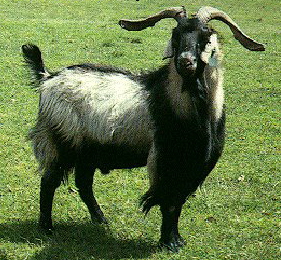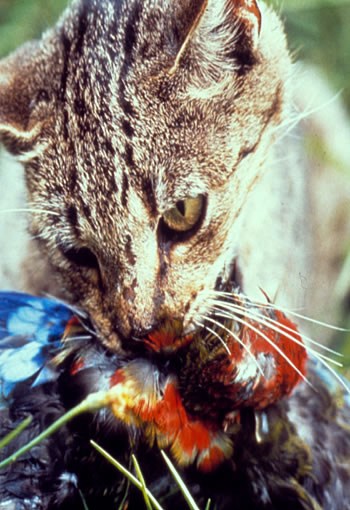|
Species |
Damage |
| Feral Rabbits | |
 |
Feral rabbits compete with native wildlife, damage vegetation and degrade the land. They ringbark trees and shrubs, and prevent regeneration by eating seeds and seedlings. Their impact often increases during drought and immediately after fire, when food is scarce and they eat whatever they can. Feral rabbits may have caused the extinction of several small (up to 5.5 kilograms) ground-dwelling mammals of Australia's arid lands, and have contributed to the decline in numbers of many native plants and animals.
|
| Feral Goats | |
 |
Feral goats have a major effect on native vegetation through soil damage and overgrazing of native herbs, grasses, shrubs and trees, which can cause erosion and prevent regeneration. They foul waterholes, and can introduce weeds through seeds carried in their dung. Particularly during droughts, feral goats can compete with native animals and domestic stock for food, water and shelter. For example, they may threaten some yellow-footed rock wallaby populations by competing for rock shelters and food, leaving the wallabies exposed to a greater risk of predation by foxes and wedge-tailed eagles. |
| Feral Pigs | |
 |
Environmental damage caused by feral pigs can be hard to measure. By wallowing and rooting around the edges of watercourses and swamps, they destroy the vegetation that prevents erosion and provides food and nesting sites for native wildlife. They compete with native animals for food, pose a threat to ground-nesting birds, and can spread environmental weeds. Feral pigs have destroyed breeding sites and degraded key habitats of endangered species Feral pigs can be a serious agricultural pest. They cause losses of an estimated 20 000 tonnes of sugarcane each year. In some areas, they kill and eat up to 40% of newborn lambs. Feral pigs could also carry diseases such as foot-and-mouth disease and swine fever, should those diseases be accidentally introduced. |
| Feral Camels | |
 |
Feral camels are capable of severely damaging native trees such as quandong and native peach, particularly during drought, when they gather in large numbers. The impact of feral camels on native plants and drinkable water is most pronounced during drought, when areas close to remote waterholes become refuges that are critical to the survival of a range of native animals and plants. Feral camels can quickly degrade these areas during a drought to the point where they may no longer provide any refuge for native plants and animals, perhaps leading to the local extinction of these species. |
| Feral Horses & Donkeys | |
 |
Feral horses and donkeys are serious environmental pests, causing erosion and damaging vegetation with their hard hoofs. They damage and foul waterholes, and introduce weeds through seeds carried in their dung, manes and tails. Feral horses and donkeys may also compete for food and water with native animals. In central Australia, feral horses overgraze large areas because they can travel up to 50 kilometres from water in search of food. This can force native wildlife from its favoured habitats. The impact of feral horses and donkeys on native grasses, herbs, shrubs and drinkable water is most pronounced during drought. They can quickly degrade areas close to remote waterholes, which during a drought become refuges critical to the survival of many native animals and plants. Without these refuges, native plants and animals may become locally extinct. |
| European Fox | |
 |
The fox has played a major role in the decline of ground-nesting birds, small to medium sized mammals such as the greater bilby, and reptiles such as the green turtle. It is thought to have caused a severe reduction in populations of many other threatened species, including the bridled nail-tail wallaby and the night parrot. The fox causes significant economic losses to farmers by preying on newborn lambs, goat kids and poultry. |
| Feral Cats | |
 |
There is clear evidence that feral cats have had a heavy impact on island fauna. On Macquarie Island, for example, feral cats caused the extinction of a subspecies of the red-fronted parakeet. On the mainland, they have probably contributed to the extinction of many small to medium sized mammals and ground-nesting birds in the arid zone, and seriously affected bilby, mala and numbat populations. In some instances, feral cats have directly threatened the success of recovery programs for endangered species. Feral cats carry infectious diseases such as toxoplasmosis and sarcosporidiosis, which can be transmitted to native animals, domestic livestock and humans. If rabies were to be accidentally introduced into Australia, there is a high risk that feral cats would act as carriers of the disease.
|